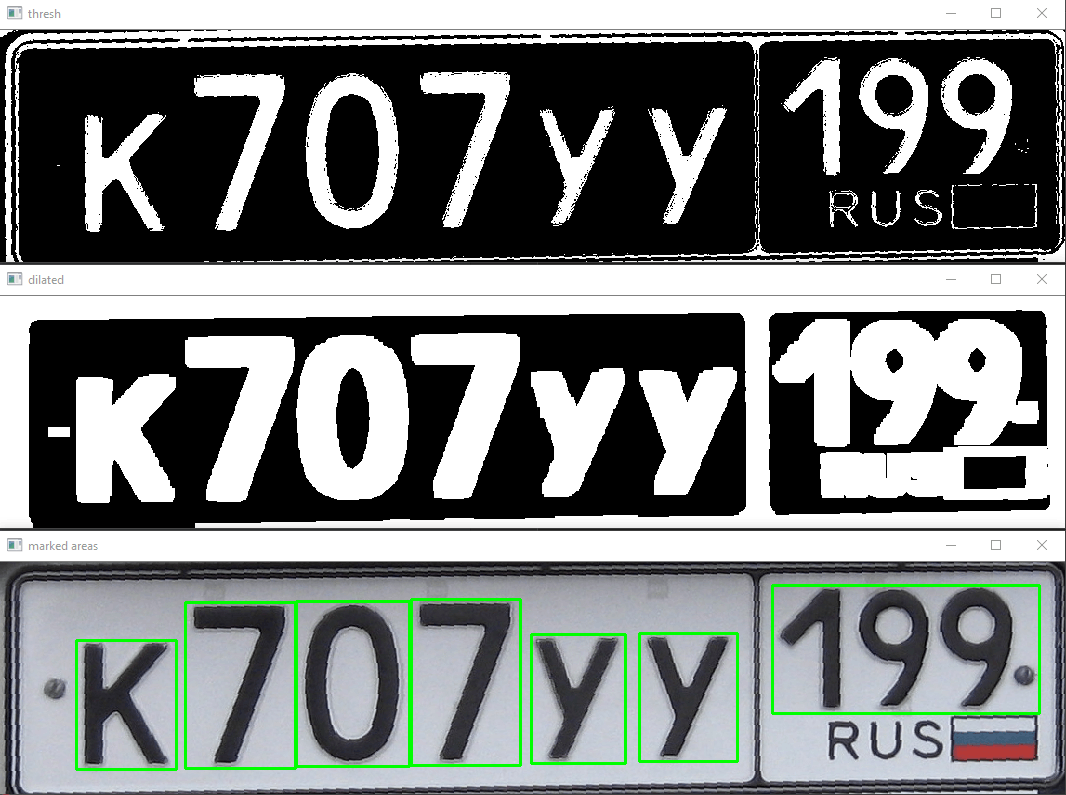Распознавание русской таблички с разным ростом символов в одной строке OpenALPR
У меня проблема с русскими пластинами. Когда я хочу классифицировать символы с помощью инструмента openalpr, я получаю что-то ниже:
OCR вырезал мой верхний фрагмент чисел. Я создаю новый файл.conf для этой страны со следующими параметрами:
char_analysis_min_pct = 0.29
char_analysis_height_range = 0.20
char_analysis_height_step_size = 0.10
char_analysis_height_num_steps = 6
segmentation_min_speckle_height_percent = 0.3
segmentation_min_box_width_px = 6
segmentation_min_charheight_percent = 0.1;
segmentation_max_segment_width_percent_vs_average = 1.95;
plate_width_mm= 520
plate_height_mm = 112
multiline = 1
char_height_mm = 58
char_width_mm = 44
char_whitespace_top_mm = 18
char_whitespace_bot_mm = 18
template_max_width_px = 300
template_max_height_px = 64
; Higher sensitivity means less lines
plateline_sensitivity_vertical = 10
plateline_sensitivity_horizontal = 45
; Regions smaller than this will be disqualified
min_plate_size_width_px = 65
min_plate_size_height_px = 18
; Results with fewer or more characters will be discarded
postprocess_min_characters = 8
postprocess_max_characters = 9
;detector_file= eu.xml
ocr_language = lamh
;Override for postprocess letters/numbers regex.
postprocess_regex_letters = [A,B,C,E,H,K,M,O,P,T,X,Y]
postprocess_regex_numbers = [0-9]
; Whether the plate is always dark letters on light background, light letters on dark background, or both
; value can be either always, never, or auto
invert = auto
У кого-нибудь есть идеи, как это решить?
Начиная использовать файл OCR из этого хранилища https://github.com/KostyaKulakov/Russian_System_of_ANPR
Спасибо.
1 ответ
Может как то так?
import cv2
import numpy as np
image = cv2.imread('plate.png')
# cv2.imshow('original', image)
gray = cv2.cvtColor(image, cv2.COLOR_BGR2GRAY)
# cv2.imshow('gray', gray)
ret, thresh = cv2.threshold(gray, 60, 255, cv2.THRESH_BINARY_INV)
cv2.imshow('thresh', thresh)
blur = cv2.medianBlur(thresh, 1)
kernel = np.ones((10, 20), np.uint8)
img_dilation = cv2.dilate(blur, kernel, iterations=1)
cv2.imshow('dilated', img_dilation)
im2, ctrs, hier = cv2.findContours(img_dilation.copy(), cv2.RETR_TREE, cv2.CHAIN_APPROX_SIMPLE)
# sort contours
sorted_ctrs = sorted(ctrs, key=lambda ctr: cv2.boundingRect(ctr)[0])
for i, ctr in enumerate(sorted_ctrs):
# Get bounding box
x, y, w, h = cv2.boundingRect(ctr)
# Getting ROI
roi = image[y:y + h, x:x + w]
if (h > 50 and w > 50) and h < 200:
# show ROI
# cv2.imshow('segment no:'+str(i),roi)
cv2.rectangle(image, (x, y), (x + w, y + h), (255, 255, 255), 1)
# cv2.waitKey(0)
cv2.imwrite('{}.png'.format(i), roi)
cv2.imshow('marked areas', image)
cv2.waitKey(0)
Это сэкономит вам всю рентабельность инвестиций, в которой вы нуждаетесь...
(последнее изображение может быть снова сегментировано)
... и сделать OCR для каждого персонажа. На мой взгляд, это может быть проще, чем делать оптическое распознавание всего изображения.
Если вы установите пороговое значение для каждого изображения и добавите 5-пиксельную рамку, IDK, тогда весь процесс будет проще.




